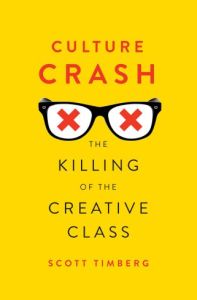Join getAbstract to access the summary!

Join getAbstract to access the summary!
Scott Timberg
Culture Crash
The Killing of the Creative Class
Yale UP, 2015
What's inside?
The 21st century’s societal, economic and technological trends endanger artists and culture.
Recommendation
Modern culture is a winner-take-all environment. The top 5% of touring pop bands currently earn around 90% of concert revenues. Movie studios and publishers put all their marketing behind the newest blockbuster or the latest bestseller and ignore everything else. As a result, says arts critic Scott Timberg, everything else disappears. Jazz combos, iconoclastic dance companies and quirky midlist authors slip away because they can’t make money. The picture Timberg paints may be too bleak, his views overly nostalgic, and he’s happily ignoring the fact that culture was thriving for centuries without any copyright protection. Nevertheless, his enthusiasm for independent arts and the artists struggling to create them is infectious. A calm, gently ironic prophet of doom, he omits only the cure, but he will make you wonder if there is one and how society could change course, reinvigorate the middle class’s involvement in the arts and sustain artists who aren’t superstars. getAbstract recommends this eloquent essay’s insights to those working in cultural institutions, creative professions and entertainment and to those who value their work.
Summary
About the Author
Arts journalist Scott Timberg is a contributor to Salon and The New York Times. A former staff writer for the Los Angeles Times, he currently runs ArtsJournal’s “Culture Crash” blog.



















Comment on this summary